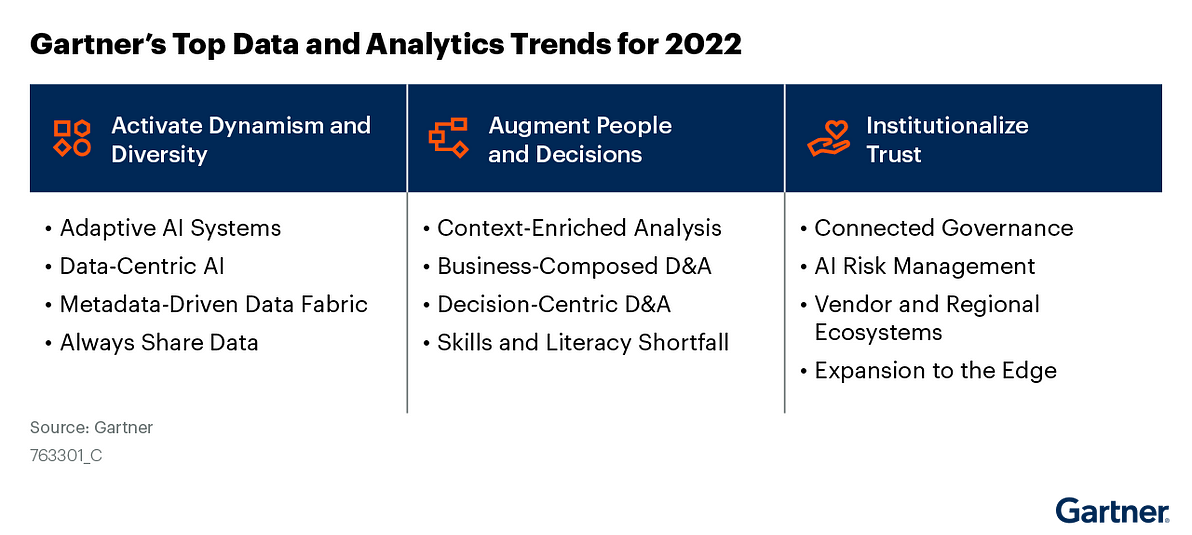By 2025, active metadata-assisted automated functions in the data fabric will reduce human effort by a third, while improving data utilization fourfold.
This is an excerpt of the publication below, with the title above, focusing on the topic in question. For the full version of the article, please, refer to the original publication.
Gartner
Top Trends in Data and Analytics, 2022
By Rita Sallam, Ted Friedman, and 37 more
11 March 2022
Excerpt by
Joaquim Cardoso MSc.
The Health Revolution
Multidisciplinary Institute for Better Health for All
May 27, 2022
Top Trends in Data and Analytics
The top D&A trends represent business, market and technology dynamics that you cannot afford to ignore

They have the potential to transform your enterprise, and will accelerate in their adoption over the next three years.
You should decide whether to proactively monitor, experiment with or aggressively invest in key trends based on their urgency and alignment to strategic priorities.
The top D&A trends and technologies do not exist in isolation; they build on and reinforce one another.
We have selected our trends for 2022 in part based on their combined effects. Taken together, our top data and analytics technology trends for 2022 will help you meet your organization’s top strategic priorities to anticipate, adapt and scale value.
This, in turn, will enable you to encourage innovation and put in place success metrics and incentives that emphasize learning and reward innovation.

Top Trends in Data and Analytics
- Group 1: Activate Dynamism and Diversity
- Group 2: Augment People and Decisions
- Group 3: Institutionalize Trust
Group 1: Activate Dynamism and Diversity
- Adaptive AI Systems
- Data-Centric AI
- Metadata-Driven Data Fabric
- Always Share Data

3.Metadata-Driven Data Fabric
Analysis by: Robert Thanaraj, Melody Chien, Ehtisham Zaidi, Mark Beyer, Mayank Talwar
SPA:
By 2025, active metadata-assisted automated functions in the data fabric will reduce human effort by a third, while improving data utilization fourfold.
By 2025, active metadata-assisted automated functions in the data fabric will reduce human effort by a third, while improving data utilization fourfold.
Description:
Metadata is “data in context” — the “what,” “when,” “where,” “who” and “how” aspects of data. The data fabric listens, learns and acts on the metadata.
It applies continuous analytics over existing, discoverable and inferenced metadata assets.
By assembling and enriching the semantics of the underlying data, the data fabric generates alerts and recommendations that can be actioned by people and systems.
It improves trust in, and use of, data in your organization as a result.
Why Trending:
Practitioners are now able to experiment with the data fabric design:
- Advancements in technology, such as graph analytics, graph-enabled machine learning, automated data content analysis and profiling, have increased the level of automation that can be introduced to data management overall.
- Cloud capacity has enabled the expansion of data assets in terms of volume and variety, while at the same time offering significantly more complex resource allocation and utilization models in an on-demand, elastic environment.
Metadata-driven data fabric has significant business value potential to:
- Reduce by 70% various data management tasks, including design, deployment and operations.
The city of Turku in Finland found its innovation held back by gaps in its data.
By integrating fragmented data assets, it was able to reuse data, reduce time to market by two-thirds and create a monetizable data fabric.
- Accelerate adoption through timely and trusted recommendations, enabling business experts to consume data with confidence.
It also enables less-skilled citizen developers to become more versatile in the integration and modeling process.
- Optimize costs, because data fabric designs are built on the foundations of balancing collect-and-connect data management strategies.
It does not require you to rip out and replace existing systems.
Data stores and applications participate by providing metadata to the data fabric.
Then, by analyzing the metadata across all participating systems, the data fabric provides insights on effective data design, delivery and utilization, thereby reducing costs.
Metadata-driven data fabric has significant business value potential to: (1) Reduce by 70% various data management tasks, including design, deployment and operations, (2) Other benefits
Implications:
- Metadata analysis can expose hidden insights into business demand, metadata sharing can speed up integration and decision making, and metadata can reinvent governance and reduce risk.
The existing data management systems, analytical platforms and systems of record are mere participating systems in the data fabric design — they feed metadata to the data fabric.
- By assembling and enriching the semantics of the underlying data, and by applying continuous analytics over metadata, the data fabric generates alerts and recommendations that can be actioned by both humans and systems.
Such a high degree of automation drives effective data design, delivery and use, reduces human efforts and yields a high ROI.
Semantic modeling skills will have a profound impact on several roles in an enterprise:
- Application developers building customer-facing applications increasingly use graph databases as the storage and execution back-end.
- Data architects designing knowledge-graph-based solutions for content management, personalization and semantic data interoperability.
- Data scientists performing higher-order exploration into connections and relationships between data points for better insights through graph visualizations, queries and algorithms.
- Database designers seeking alternative solutions to growing volumes of semistructured data.
Recommendations:
Data and analytics leaders should:
- Start monitoring how data is used, and leverage discovery tools to look for new and unexpected uses of data.
This might imply new opportunity, or an emerging risk that warrants some attention.
- Target known opportunities and pain points by investing in experimentation and innovation with metadata.
Assess ways to capture system logs, user logs, transaction logs and current data locations from your existing systems.
There will be initial pushbacks from your application owners — create a shared benefit statement.
- Initiate a pilot effort to build a “limited” data fabric by identifying an intersection of data used, use cases, users and systems performing the data management, and the affected business units.
Changes Since Last Year
The data fabric trend progresses toward augmented data management principles by generating recommendations and alerts to its participating systems and individuals.
We have published a few case studies on initiatives that have already begun to show real benefits, such as that of Montefiore.
Originally published at https://www.gartner.com












